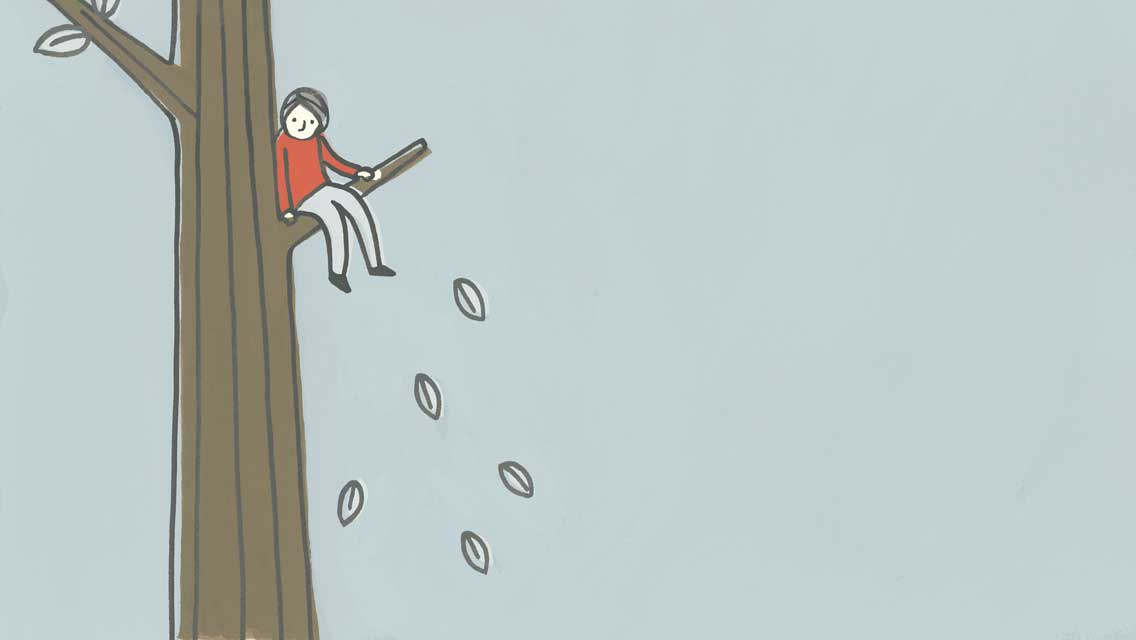Like many people in their middle years, Jonathan Rauch was increasingly discontented with his life. He’d written numerous books, won a prestigious National Magazine Award, and was enjoying a successful romantic relationship. “Yet I began to feel a sense of restlessness and malaise, my achievements didn’t feel rewarding, and I didn’t feel grateful for all the good things in my life,” he says.
Years later, Rauch learned he had experienced the trough of “the happiness curve” — a naturally occurring U-shaped life-satisfaction pattern found in humans as well as orangutans and chimpanzees.
Research by psychologists, behavioral scientists, and economists has revealed a common trajectory of contentedness over the course of one’s life. This includes a period of natural excitement and optimism in young adulthood; a time of consolidation and achievement coupled with a gradual sense of disappointment and declining optimism in the middle years; a recalibration and upturn of life satisfaction in late middle age; and happiness in late adulthood.
“The passage of time by itself affects how satisfied and grateful we feel — or, more precisely, how easy it is to feel satisfied and grateful,” writes Rauch in his book The Happiness Curve: Why Life Gets Better After 50.
The Brookings Institution senior fellow hopes his book will help shift narratives about aging from discussions of midlife crises to ones about midlife growth. “It’s not that there’s something wrong with your life or something wrong with you,” he says. “It’s a normal transition with a really excellent payoff when you come out on the other side.”
Q&A With Jonathan Rauch
Experience Life | What’s happening during the happiness curve?
Jonathan Rauch | First, our optimism level changes. When we’re young, we’re energized and motivated. We also tend to overestimate how happy we’re going to be in midlife as we achieve our goals.
We think money will make us happy, but getting richer doesn’t necessarily make you happier. Research also shows that as countries experience economic growth, the residents tend to feel less happy. This is known as the paradox of “happy peasants and frustrated achievers.”
Another factor is that as soon as we get the promotion or raise, our baselines readjust and the goalposts move, leaving us feeling frustrated. This is called the paradox of the “hedonic treadmill,” because no matter how fast you run, you actually stay in the same place. Over time, this wears you down.
Second, our values are changing. Instead of wanting to continue putting points on the board by buying the big house or new car, we begin to want different things. Eventually, by the time we’re on the upswing of the curve — around 50 and increasingly into our 60s, 70s, and 80s — what we value moves away from social competition toward social connection. We begin connecting to the individuals we care most about and investing in the well-being of others and activities that we enjoy the most.
And guess what? Those things aren’t on the hedonic treadmill, and the goalposts don’t move. Those are much better ways to be happy.
Finally, as we age, our brains become more weighted toward positivity. These changes can be seen in brain MRI scans. Over time, we experience less stress, regret, and emotional volatility. We get better tools for being wise. We have more balance, perspective, and experience.
EL | What can we do to make this midlife transition easier?
JR | First, normalize the situation! Understand that there’s nothing wrong with you, and there’s something right with you. The happiness curve gets worse if you start to think that you’re abnormal or mentally ill.
Second, don’t get isolated. Many people are ashamed during this time because at age 45 or 50 we’re supposed to be on top of the world, masters of the universe. However, it’s a vulnerable period of transition. We’re not sure who we are. We’re not sure if we want the things that we wanted 20 years ago. In fact, we almost certainly don’t. So talk to your friends about it. Coaching and counseling are also valuable.
Maybe the most important thing is to wait it out. The fog will lift, so don’t make rash decisions. Step, don’t leap into change.
EL | What changes can we make on a societal level to support people in the midst of a happiness slump?
JR | These changes are more important than the personal changes. There are millions of people in this stage of life experiencing values changes who want to move to different kinds of work. It’s essential that we build systems and mechanisms that help them do things like go back to school, take gap years, and do adult internships.
We also need to develop jobs that are less demanding and more about mentoring than producing for people in their 60s and 70s. This will help those in midlife as well, because once people get to 45 or 50, they’ll be expecting to think about changing their lives and there’ll be lots of channels for them to explore. Their future won’t feel so pessimistic.
We also need to be kinder and more supportive of one another. We want those experiencing the happiness dip to share what they’re going through.
EL | Why is shifting the language we use about aging important?
JR | It’s unfortunate that the middle years of our lives have become a source of mockery. The term “midlife crisis” is damaging. It shames those who are going through a very natural satisfaction dip and are already feeling like something is wrong with them.
We also need new language to talk about and describe the years between 65 and 80 — what some people call “encore adulthood.”
These days, this is a gift of 15 years of generally healthy, vibrant life. While we still tend to think of people in this age bracket as old, retired, and ready to die, that’s inaccurate. These people want a new start in life. Their values have changed toward compassion, and they’re seeking ways to contribute and give back, but they don’t have any guideposts.
It’s exciting to be in the midst of this important discussion of redefining how we think about human adult development. These are fundamental conversations about what we think of as the stages of life. People who are now in the midst of the happiness curve are leading the way. I believe the end result will be that in a couple of decades there will be a much better fit between how people actually age and the world they have to fit themselves into.




This Post Has 0 Comments